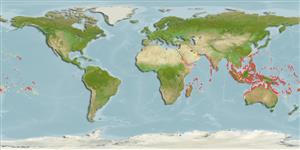Gastropoda |
Littorinimorpha |
Strombidae
Environment: milieu / climate zone / пределы глубины / distribution range
экология
; пределы глубины 0 - 24 m (ссылка 349). Tropical; 29°N - 29°S, 33°E - 126°W
Indo-Pacific: from East Africa, India, Sri Lanka, Andaman and Nicobar Islands, east to southeast Asia and Australia, as far east to French Polynesia and north to Japan. Subtropical and tropical.
Length at first maturity / Size / Weight / Возраст
половая зрелость: Lm ? range ? - ? cm Max length : 29.0 cm SHL самец/пол неопределен; (ссылка 349); common length : 18.0 cm SHL самец/пол неопределен; (ссылка 349)
Sexual dimorphism pronounced. Shell of the males usually smaller and with shorter digitations on the outer lip.
Often collected for food by coastal populations, and the shell used in shellcraft (Ref. 349). Maximum depth from Ref. 106336. Occurs at the low tide mark (Ref. 349), intertidal and found on subtidal reef and seagrass (Ref. 98588). It is also found on sand, weeds near corals (Ref. 799), muddy areas (Ref. 97553), reef-flats, coral rubble bottoms or mangrove areas (Ref. 128042). Shallowly burrows in sand or gravel. Grazes on animal matter in the mud. Also predominantly feeds on sand grains, polychaetes, bivalves and small crustaceans (Ref. 97553).
Life cycle and mating behavior
половая зрелость | размножение | нерест | Eggs | Fecundity | Larvae
Members of the order Neotaenioglossa are mostly gonochoric and broadcast spawners. Life cycle: Embryos develop into planktonic trocophore larvae and later into juvenile veligers before becoming fully grown adults.
Основная ссылка
ссылки | координатор | соавторы
Poutiers, J.M. 1998 Gastropods. p. 363-648. In Carpenter, K. E. and V. H. Niem. 1998. FAO species identification guide for fishery purposes. The living marine resources of the Western Central Pacific. Volume 1. Seaweeds, corals, bivalves, and gastropods. Rome, FAO. (ссылка 349)
Статус Красного Списка МСОП
(ссылка 130435: Version 2025-1)
Статус СИТЕС (ссылка 108899)
Not Evaluated
CMS (ссылка 116361)
Not Evaluated
Угроза для людей
Harmless
Использование человеком
рыболовство: коммерческий
| FishSource | Sea Around Us
инструменты
дополнительная информация
Population dynamicsростMax. ages / sizesLength-weight rel.Length-length rel.Размерный составMass conversionчисленность Life cycleразмножениеполовая зрелостьFecundityнерестEggsРазвитие икрыLarvae PhysiologyOxygen consumption
Human RelatedStamps, coins, misc.
ресурсы в Интернет
Estimates based on models
Preferred temperature
(Ref.
115969): 25.2 - 29.3, mean 28.5 (based on 3353 cells).
Prior r = 0.57, 95% CL = 0.37 - 0.85, Based on 1 data-limited stock assessment.
Fishing Vulnerability
Low vulnerability (19 of 100).
Категория цены
Unknown.
Nutrients : Calcium = 126 [75, 177] mg/100g; Iron = 4.79 [1.67, 7.92] mg/100g; Protein = 15.9 [14.8, 16.9] %; Omega3 = 0.331 [0.263, 0.400] g/100g; Selenium = 57.8 [48.5, 67.2] μg/100g; VitaminA = 0 μg/100g; Zinc = 1.97 [0.92, 3.02] mg/100g (wet weight); based on
nutrient studies.
